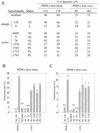Bovine leukemia virus-induced persistent lymphocytosis in cattle does not correlate with increased ex vivo survival of B lymphocytes
- PMID: 9882314
- PMCID: PMC103933
- DOI: 10.1128/JVI.73.2.1127-1137.1999
Bovine leukemia virus-induced persistent lymphocytosis in cattle does not correlate with increased ex vivo survival of B lymphocytes
Abstract
Bovine leukemia virus (BLV) is an oncogenic retrovirus associated with B-cell lymphocytosis, leukemia, and lymphosarcoma in the ovine and bovine species. We have recently reported that in sheep, BLV protects the total population of peripheral blood mononuclear cells (PBMCs) from ex vivo spontaneous apoptosis. This global decrease in the apoptosis rates resulted from both direct and indirect mechanisms which allow extension of cell survival. Although sheep are not natural hosts for BLV, these animals are prone to develop virus-induced leukemia at very high frequencies. Most infected cattle, however, remain clinically healthy. This difference in the susceptibilities to development of leukemia in these two species might be related to alterations of the apoptotic processes. Therefore, we designed this study to unravel the mechanisms of programmed cell death in cattle. We have observed that PBMCs from persistently lymphocytotic BLV-infected cows were more susceptible to spontaneous ex vivo apoptosis than cells from uninfected or aleukemic animals. These higher apoptosis rates were the consequence of an increased proportion of B cells exhibiting lower survival abilities. About one-third of the BLV-expressing cells did not survive the ex vivo culture conditions, demonstrating that viral expression is not strictly associated with cell survival in cattle. Surprisingly, culture supernatants from persistently lymphocytotic cows exhibited efficient antiapoptotic properties on both uninfected bovine and uninfected ovine cells. It thus appears that indirect inhibition of cell death can occur even in the presence of high apoptosis rates. Together, these results demonstrate that the protection against spontaneous apoptosis associated with BLV is different in cattle and in sheep. The higher levels of ex vivo apoptosis occurring in cattle might indicate a decreased susceptibility to development of leukemia in vivo.
Figures





References
-
- Arai M, Kannagi M, Matsuoka M, Sato T, Yamamoto N, Fuji M. Expression of FAP-1 (Fas-associated phosphatase) and resistance to Fas-mediated apoptosis in T cell lines derived from human T cell leukemia virus type 1-associated myelopathy/tropical spastic paraparesis patients. AIDS Res Hum Retroviruses. 1998;14:261–267. - PubMed
-
- Burny A, Cleuter Y, Kettmann R, Mammerickx M, Marbaix G, Portetelle D, Van den Broeke A, Willems L, Thomas R. Bovine leukemia: facts and hypotheses derived from the study of an infectious cancer. Adv Vet Sci Comp Med. 1988;32:149–170. - PubMed
-
- Chlichlia K, Moldenhauer G, Daniel P T, Busslinger M, Gazzolo L, Schirrmacher V, Khazaie K. Immediate effects of reversible HTLV-I tax function: T-cell activation and apoptosis. Oncogene. 1995;10:269–277. - PubMed
-
- Chlichlia K, Busslinger M, Peter M E, Walczak H, Krammer P H, Schirrmacher V, Khazaie K. ICE-proteases mediate HTLV-I Tax induced apoptotic cell death. Oncogene. 1997;14:2265–2272. - PubMed
Publication types
MeSH terms
Substances
LinkOut - more resources
Full Text Sources

